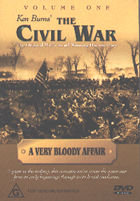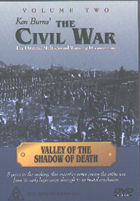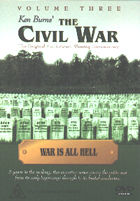 |
 |
 |
|
DOCUMENTARIES The Civil War: Volumes 1-3
Five years in the making, a massive 11 hours of TV using still photos in a world of live-footage freaks, no big-name actors or flashy gimmics, just true stories reported about - and people who witnessed - the cataclysmic split America suffered between 1861-1865. The Civil War is a landmark production so superior to almost anything else ever produced for TV - it is rivalled only by The World at War - it may never be equalled. And now, at last, The Civil War has made it on to DVD and it is the perfect show to have on disc. The DVDs allow you to navigate through the massive series and easily find something you wanted to look at again. Burns used over 16,000 still photos in the epic production and came up with an innovative way of filming the images and thereby adding a stylish form of movement while getting incredible detail out of the old plates.
The title music, the haunting Ashokan Farewell will get in your blood and you may find yourself unconciously whistling it. David McCullough, the narrator, has an absolutely magical voice - as has a very impressive lineup of character voices who read from personal diaries and letters of eyewitnesses to the battlefield carnage, political goings on and life on the homefront. They include Morgan Freeman, Jason Robards, Sam Waterson, Derek Jacobi and Jeremy Irons. Blended in to that mix are explanatory to-camera pieces by eminent historian Barbara Fields and celebrated historical writer Shelby Foote, who is the epitomy of a Southern gentleman.
Above all, however, The Civil War stands as a monumental achievement of managing to encapsulate the bitter struggle between the North and the South in an enthralling way. 40 million Americans watched it first time around and if you want to see something truly wonderful then you'll do so too. Conclusion: 95% Volume 1 Episode One: The Cause As one would expect this examines the major causes of the American Civil War and the leading players on both sides. Slavery is looked at and while that itself did not cause the war, abolitionist activist John Brown's (of John Brown's Body fame) attack on a southern armoury at Harper's Ferry certainly speeded things up. The main reason for the war was the key issue of states' right and whether they could vote to leave the American Union. Whatever the causes, the first major battle at Manassas (Bull Run) was a humiliating defeat for the much stronger North. Episode Two: A Very Bloody Affair In 1862, as both sides settle into preparations for a long and drawn out war, the world witnesses the first clash of ironclad ships - the Merrimac and the Monitor - and the politics as European nations get close to recognising the Confederacy (South) as an independent country. While the Union has the bigger army it cannot find a man to lead it and, desperate to turn things around, President Abraham Lincoln goes for a drinker and failed businessman in Ulysses S. Grant. The result is the battle of Shiloh. Episode Three: Forever Free By the middle of 1862, Lincoln is in real trouble and wants to use the freeing of slaves (only in the South however) as a way to unite the North and lessen the likelihood of European intervention in the war. He needs a battle victory and General George McClellan is about to deliver him one - the bloodiest day's fighting of the war - at Antietam. Volume 2 Episode Four: Simply Murder 1863 was the crucial year in the war and the North began it with a disaster at Fredericksburg, a sound beating at Chancellorsville. Anti-war sentiment in the North was brewing while, in the South, wartime deprivations were hitting civilians hard. Episode Five: The Universe of Battle This episode covers the turning point in the Civil War where 150,000 men battled it out in the three-day clash at Gettysburg. The tide begins to move against the South and Lincoln makes his stunning Gettysburg Address. The battles of Vicksburg, Chickamauga and Chattanooga feature prominently. Episode Six: Valley of the Shadow of Death The two leading generals of the Civil War, General Robert E. Lee and General Ulysses S. Grant, are compared in detail and this examination leads into their struggle for Virginia in 1864. Within a month both men lose more soldiers than in all the previous battles. Facing re-election, Lincoln looks like losing both the race for the presidency - and the war. Volume 3 Episode Seven: Most Hallowed Ground This focuses on Lincoln's fight for political survival - and that of the Union - but his commanders give him battle victories at Atlanta and in the Shenandoah Valley. The lifelines once again swing the tide of the war in favour of the North and General Lee's house is commandeered by his enemies for use as Arlington National Cemetery. Episode Eight: War is All Hell Depending upon the side you supported in the Civil War you'll have mixed feelings about General Sherman's "March to the Sea". The no-holds-barred campaign saw incalculable destruction throughout the South and finished the Confederacy as a serious threat to the North. With his armies exhausted and vastly outnumbered Lee surrenders at Appomattox Courthouse. Episode Nine: The Better Angels of Our Nature Although defeated, some in the South dream of ultimate victory and plot to assassinate Lincoln. Only five days after the end of the war, John Wilkes Booth shoots and mortally wounds the president. This final episode wraps up the series and looks at the effects the war had on America. It also tells you what happened to all the characters you have listened to while watching and rounds the whole thing off beautifully.
|
|
|
Napoleon
Bonaparte
|
|
| Career | Portraits |
| Quotes | Family |
| Loves | Letters |
| Plots | Murdered? |
| His will | Places |
|
Era
of Napoleon
|
|
| Powers | Opponents |
| Coalitions | Allies |
| People | Timelines |
| Key sites | Shrapnel |
|
Warfare
|
|
| Campaigns | Battles |
| Armies | Generals |
| Marshals | Winners |
| Glossary | Medical |
| Weapons | 1812 War |
| Uniforms | Battlefields |
|
War
at Sea
|
|
| Naval War | Heroes |
| Artworks | Signals |
| Nelson | Trafalgar |
|
Maps
|
|
| Key Maps | Peninsula |
| Animated | 1796/1800 |
| 1809 | Russia |
|
French
Revolution
|
|
| Revolution | Guillotine |
| Posters | People |
|
Art,
Film, Games
|
|
| Education | Goya |
| Sharpe | Hornblower |
| Books | Movies |
| DVDs | Music |
| Wargames | Images |
| Cartoons | Caricatures |
|
Other
|
|
| About Us | Sources |
| Awards | Sitemap |
| Links | Militaria |
| Miniatures | Reenactors |
| Forum | Quizzes |
| Home | Waterloo Diorama |
 Ken
Burns really should have been locked up for even thinking about
such a project.
Ken
Burns really should have been locked up for even thinking about
such a project.  The
music of the Civil War period is usually lively and brings an interesting
counterpoint of life to the darker images and details of the bloody
battles that killed more Americans than any wars since.
The
music of the Civil War period is usually lively and brings an interesting
counterpoint of life to the darker images and details of the bloody
battles that killed more Americans than any wars since.  The
transfer on to DVD is very good, although not pristine, but who
the heck cares? This is riveting stuff.
The
transfer on to DVD is very good, although not pristine, but who
the heck cares? This is riveting stuff. 